Part 4: Concrete and Steel (Chapters 19 and 22)
This five-part series discusses significant structural changes to the 2021 International Building Code (IBC) by the International Code Council (ICC). Part 4 includes an overview of changes to Chapter 19 on concrete and Chapter 22 on steel. Only a portion of the total number of code changes to these chapters are discussed in this article. More information on the code changes discussed here can be found in the 2021 Significant Changes to the International Building Code, available from ICC (Figure 1).
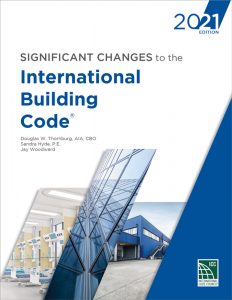
IBC Chapters 19 and 22 provide minimum accepted practices for designing and constructing buildings and structural components using concrete and steel, respectively. The following modifications were approved for the 2021 IBC. New text is shown in underline format with a brief description of the change’s significance.
Concrete Design and Construction
The American Concrete Institute’s ACI 318, Building Code Requirements for Structural Concrete, has been updated to the 2019 edition (Figure 2) and includes changes addressing deep foundations, materials, and seismic design.
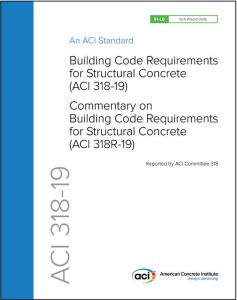
1901.2 Plain and reinforced concrete. Structural concrete shall be designed and constructed in accordance with the requirements of this chapter and ACI 318 as amended in Section 1905 of this code.
Chapter 35
318-19: Building Code Requirements for Structural Concrete & Commentary
Change Significance: ACI 318 includes requirements for the design and construction of structural concrete necessary to ensure public health and safety. The 2019 edition is now referenced, with changes that respond to new developments in materials, structural systems, and seismic design. Not only have the structural design provisions changed, but materials’ advancement and placement techniques are also addressed, resulting in procedural changes of interest to both manufacturers and contractors.
Structural Concrete Tolerances
American Concrete Institute standards ACI 117-10, Specification for Tolerances for Concrete Construction and Materials, and ACI ITG-7-09, Specification for Tolerances for Precast Concrete, have been added to the IBC by reference to provide acceptable tolerances for concrete construction (Figure 3).
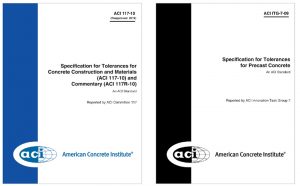
1901.7 Tolerances for structural concrete. Where not indicated in construction documents, structural tolerances for concrete structural elements shall be in accordance with this section.
1901.7.1 Cast-in-place concrete tolerances. Structural tolerances for cast-in-place concrete structural elements shall be in accordance with ACI 117.
Exceptions:
1. Group R-3 detached one- or two-family dwellings are not required to comply with this section.
2. Shotcrete is not required to comply with this section.
1901.7.2 Precast concrete tolerances. Structural tolerances for precast concrete structural elements shall be in accordance with ACI ITG-7.
Exception: Group R-3 detached one- or two-family dwellings are not required to comply with this section.
Chapter 35
ACI 117-10: Specification for Tolerances for Concrete Construction and Materials
ACI ITG-7-09: Specification for Tolerances for Precast Concrete
Change Significance: Two standards are now referenced for allowable tolerances of structural concrete elements when such tolerances have not been indicated in construction documents, providing building departments, designers, contractors, and special inspectors with information necessary for concrete design and construction within appropriate tolerances.
ACI 117 designates standard tolerances for concrete construction. Applicable to exposed concrete and architectural concrete, tolerances in the specification are for typical concrete construction and construction procedures. Materials that interface with or connect to concrete elements may have tolerance requirements that are not compatible with those contained in ACI 117. Care should be taken to verify that concrete tolerances work with steel or wood tolerances of each structural assembly. This specification does not apply to precast concrete or shotcrete.
ACI ITG-7 provides standard tolerances for precast concrete construction, deals with dimensional tolerances for precast concrete members used in building construction, and addresses erection tolerances for individual members. Engineers may also specify project-specific requirements in the contract documents rather than using the provisions of ACI ITG-7.
As a best practice, a series of preconstruction tolerance coordination meetings should be scheduled and held before the commencement of concrete work. The contractor, subcontractors, material suppliers, and other key parties should all attend. At the meeting, all should be given an opportunity to identify any tolerance questions and conflicts applicable to the work with materials, prefabricated elements, and work to be assembled or installed in the field by the contractor.
Seismic Steel Moment Frame Prequalified Connections
AISC 358, Prequalified Connections for Special and Intermediate Steel Moment Frames for Seismic Applications, includes requirements for design, detailing, fabrication, and quality control of tested connections for use with intermediate and special moment frames. In the past, AISC 358 was directly referenced in AISC 341, Seismic Provisions for Structural Steel Buildings, which is referenced in the IBC. Applicable provisions of AISC 358 are now referenced in the 2021 IBC.
Notably, in the 2021 IBC, beam-column moment connections in Seismic Design Category B and C buildings are now required to be prequalified where the response modification coefficient exception is not applied.
2205.2.1.1 Seismic Design Category B or C. Structures assigned to Seismic Design Category B or C shall be of any construction permitted in Section 2205. Where a response modification coefficient, R, in accordance with ASCE 7, Table 12.2-1, is used for the design of structures assigned to Seismic Design Category B or C, the structures shall be designed and detailed in accordance with the requirements of AISC 341. Beam-to-column moment connections in special moment frames and intermediate moment frames shall be prequalified in accordance with AISC 341 Section K1, qualified by testing in accordance with AISC 341 Section K2, or shall be prequalified in accordance with AISC 358.
Exception: The response modification coefficient, R, designated for “Steel systems not specifically detailed for seismic resistance, excluding cantilever column systems” in ASCE 7, Table 12.2-1, shall be permitted for systems designed and detailed in accordance with AISC 360, and need not be designed and detailed in accordance with AISC 341.
2205.2.1.2 Seismic Design Category D, E or F. Structures assigned to Seismic Design Category D, E or F shall be designed and detailed in accordance with AISC 341, except as permitted in ASCE 7, Table 15.4-1. Beam-to-column moment connections in special moment frames and intermediate moment frames shall be prequalified in accordance with AISC 341 Section K1, qualified by testing in accordance with AISC 341 Section K2, or shall be prequalified in accordance with AISC 358.
Change Significance: Supplements to AISC 358 are now produced more frequently than new editions of AISC 341, with the net effect of not recognizing newer steel provisions in the code which leads to confusion among building officials, registered design professionals, and manufacturers regarding prequalified connections. The most up-to-date standard is accommodated by directly referencing AISC 358 in the IBC. AISC 358 is just one approach for designing structural steel connections for seismic loads. Section K1 or K2 of AISC 341 may also be used. Section K1 offers minimum requirements for the process of prequalifying a beam-to-column connection used in a special or intermediate moment frame. The intent is to allow the use of a few connection configurations tested to the point where typical performance is understood for a narrow set of construction tolerances. Both Section K1 and AISC 358 are based on the premise of a pre-tested connection for a moment frame. Section K2 of AISC 341, addressing testing requirements for both beam-to-column moment frame connections and link-to-column braced frame connections, includes a simplified list of requirements that can be used to create a specific beam-column connection test protocol.
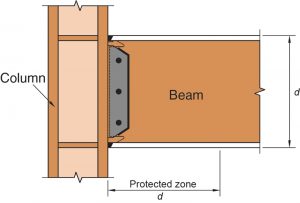
Examples of prequalified moment frame connections are a welded unreinforced flange-welded web (WUF-W) connection (Figure 4) and a bolted flange plate (BFP) connection (Figure 5). Each structural steel connection ties a beam to a column.
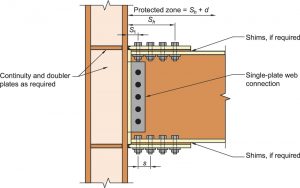
Cantilevered Steel Storage Racks
Requirements for cantilevered steel storage racks and their anchorage qualification continue to be clarified (Figure 6).
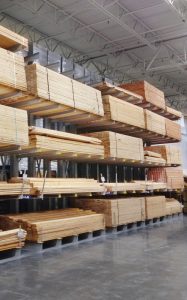
2209.3 Certification. For rack storage structures that are 8 feet in height or greater to the top load level and assigned to Seismic Design Category D, E, or F at completion of the storage rack installation, a certificate of compliance shall be submitted to the owner or the owner’s authorized agent stating that the work was performed in accordance with approved construction documents.
202 Definitions:
STORAGE RACKS, STEEL. Cold-formed or hot-rolled steel structural members which are formed into steel storage racks, including pallet storage racks, movable-shelf racks, rack-supported systems, automated storage and retrieval systems (stacker racks), push-back racks, pallet-flow racks, case-flow racks, pick modules, and rack-supported platforms. Other types of racks, such as drive-in or drive-through racks, cantilever racks, portable racks, or racks made of materials other than steel, are not considered storage racks for the purpose of this code.
STORAGE RACKS, STEEL CANTILEVERED. A framework or assemblage comprised of cold-formed or hot-rolled steel structural members, primarily in the form of vertical columns, extended bases, horizontal arms projecting from the faces of the columns, and longitudinal (down-aisle) bracing between columns. There may be shelf beams between the arms, depending on the products being stored; this definition does not include other types of racks such as pallet storage racks, drive-in racks, drive-through racks, or racks made of materials other than steel.
Change Significance: The design of components utilized in steel storage racks is based on minimum thicknesses and minimum yield strength. Storage rack systems can be complex, and their fabrication and installation must comply with approved drawings. Installation and anchorage of storage racks in high seismic regions require special inspection. In addition, a certificate of compliance is to be provided to the building official stating that the rack was fabricated and installed to meet the requirements in the approved construction documents.
The addition of a steel cantilevered storage rack definition acknowledges that this common type of storage rack has different load and design requirements than a standard steel storage rack. The definition for steel cantilevered storage racks is consistent with that found in ASCE 7, Minimum Design Loads and Associated Criteria for Buildings and Other Structures, Section 11.2 and states explicitly that the racks will be made of structural steel, that the arms cantilever, and that the definition does not apply to other types of steel storage racks.
Conclusion
Structural engineers responsible for steel and concrete design should be aware of significant structural changes in the 2021 IBC. First, the latest ACI 318 standard is referenced along with references to ACI provisions for concrete construction tolerances. Second, AISC 358 is now directly referenced for design of structural steel connections for seismic loads. Finally, the addition of a steel cantilevered storage rack definition acknowledges that this common type of storage rack has different load and design requirements than a standard steel storage rack.■
Parts 1 through 3 of this series ran in STRUCTURE November 2021 (Loads), December 2021 (Foundations), and January 2022 (Special Inspections), respectively.
